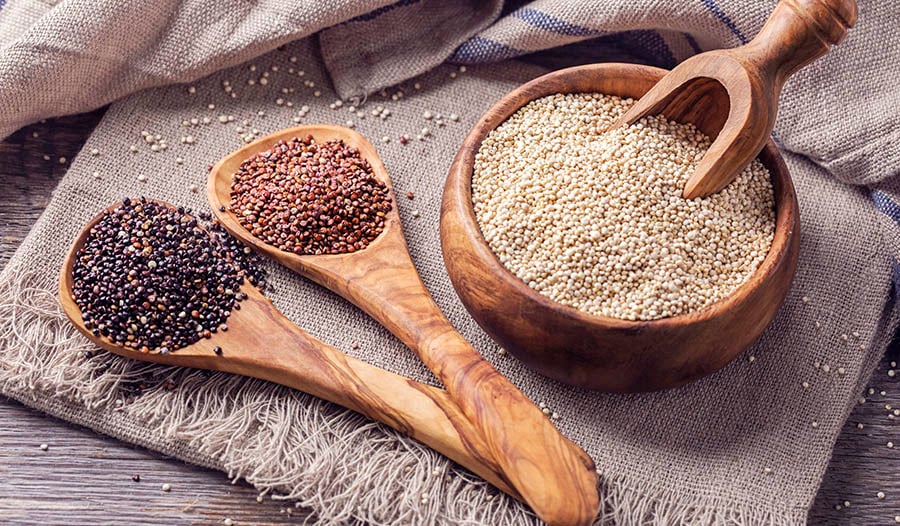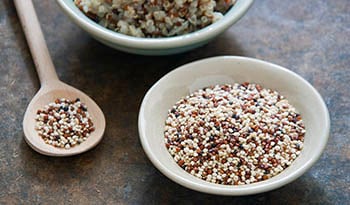6 Peruvian Superfoods with Incredible Health Benefits
DISCLAIMER:This blog does not intend to provide diagnosis...
- In this article:
- 1. Camu-Camu
- 2. Lucuma
- 3. Maca
- 4. Quinoa
- 5. Sacha Inchi
- 6. Yacon
- Peruvian Superfood Recipes
- Peruvian Superfood Smoothie Recipe
- Quick Quinoa Protein Pudding Recipe
- Yacon Syrup Usage Suggestions

Originally posted May 2018 / Updated April 2023
Peru possesses 90 microclimates due to its expansive coastline, the dramatic changes in altitude in the peaks and valleys of the Andes, and the fact it comprises 13% of the Amazonian rainforest. The tremendous variety in climate and altitude gives Peru a wide variety and abundance of plant and animal life.
Foods that are grown in Peru's rich soil and clean air are often superior in the composition of vitamins, minerals, and phytochemical antioxidants. Many of these foods from Peru are deemed superfoods, including camu-camu, lucuma, maca, quinoa, sacha inchi, and yacon, which can offer insight into incorporating these ingredients into diet regimens or meal plans.
1. Camu-Camu
Camu-camu is an edible fruit from the Myrciaria dubia plant in the Amazon rainforest. Ranging in color from light pink to a vivid red-orange this fruit contains an exceptionally high concentration of vitamin C, carotenoid, and flavonoid compounds that act as antioxidants. Studies have shown that one serving of camu-camu can contain 60 times more vitamin C than an orange. Preliminary research shows positive effects supporting blood pressure, blood sugar levels, and obesity.
Many health experts recommend eating camu-camu to help boost the immune system and promote longevity.
In addition to the antioxidant vitamin C, camu-camu also contains carotenoid and flavonoid compounds. Scientific research indicates that, like other high-antioxidant foods, camu-camu may reduce inflammation, blood pressure, and the risk for heart disease.1
Camu-camu is most often available in a powdered form, making it easy to add to a smoothie, juice, and soup recipes. The fruit has a naturally tart flavor that pairs well with sweeteners.
2. Lucuma
Lucuma is a tropical and subtropical fruit harvested from the Pouteria lucuma tree native to the Andean region of Peru. Lucuma, known for vivid orange flesh, was nicknamed the "gold of the Incas." Lucuma's flavor blends maple, sweet potato, and fresh caramel. It is the most popular ice cream flavor in Peru.
Lucuma has been used as a traditional remedy in South America for centuries. It is now commonly found in powder supplement form and touted for its many potential health benefits. Lucuma is rich in dietary fiber, potassium, magnesium, and antioxidants (mainly carotenoids and flavonoids).2
3. Maca
Maca (Lepidium meyenii) is a cruciferous (cabbage) family member and is a close relative of the turnip. However, consider it more of a superfood version. One of the unique phenomena in adapting a plant to its environment is that stressors like altitude and temperature changes can significantly influence the formation of protective factors within the plant to help it survive. Often, these compounds also exert significant health-improving effects in humans.
Peruvian maca is an excellent example of this environmental influence on a plant's chemical composition. First, it is harvested from the high Andes region of Peru, where the elevation is typically 11,000 to 14,000 feet. That elevation is above the tree line and below the permanent snow cap. Maca is the highest-elevation food crop in the world. At any time of the year, temperatures can range from below freezing to 60° F. All these environmental stressors result in the unique chemical composition of maca grown in Peru. It truly is a gift.
Maca contains many unique compounds, but like other cruciferous vegetable family members, maca contains glucosinolates. These compounds are valuable agents in kale, cabbage, broccoli, etc., positively influencing hormonal metabolism. Maca's glucosinolates are unique in structure and action (they are more potent). Maca also contains some unique alkaloids collectively called macamides, including macaridine and macaene. Alkaloids are generally fast-acting compounds. These alkaloids of maca exert their action on central control mechanisms in the hypothalamus, pituitary, adrenals, and other endocrine organs. Glucosinolates and alkaloids are just two classes of compounds that contribute to the actions of maca, but flavonoids, alkamides, and sterols are also important.3
Maca is a food. And as such, there is evidence to support its health-promoting effects. Maca consumption is associated with significantly higher scores in health status and lower levels of markers for inflammation and oxidative damage.4,5
One of the consistent findings in the human clinical data is that Maca boosts mood scores, reduces the feeling of stress and anxiety, and increases perceived energy levels.4
Maca is an "adaptogen." Adaptogens historically been used to:
- Restore vitality in debilitated and feeble individuals
- Increase feelings of energy
- Improve mental and physical performance
- Prevent the adverse effects of stress and enhance the body's response to stress
Perhaps maca's most renowned benefit is enhancing sexual desire and function for both men and women. Clinical trials confirm these properties.6-8 The reality is that sexual dysfunction is highly prevalent in modern society worldwide, affecting 20–30% of men and 40–45% of women. In men, maca does not appear to affect the testosterone level directly. Instead, it acts on the entire endocrine system to reduce the harmful effects of stress while improving mood, energy, and endurance.7
Maca also helps menopausal women reduce the frequency of hot flushes, night sweating, interrupted sleep patterns, nervousness, depression and heart palpitations. There was also a reduction in body weight and blood pressure and increased serum HDL cholesterol and iron. These results support the historical use of maca in postmenopausal women.9
The standard dose for dried powdered Maca is typically 1,500-3,000 mg once or twice daily. Higher dosages may be required for more therapeutic effects, but a daily dosage of 1.5-6 g is appropriate for a general health boost.
4. Quinoa
Quinoa is an edible seed native to the Andean mountain range in Peru. Although it is more closely related to beets and spinach than to grains, the grain-like traits of quinoa make it a valuable ingredient for meals ranging from breakfast to dinner. Peru produces more than 50% of the quinoa grown in the world.
Because it is not a grain, quinoa offers a perfect alternative for people with grain or gluten sensitivities. Quinoa is composed of 18% plant protein, resulting in a nutrient-dense food that may help the stomach feel fuller longer. Due to its vitamin density and therapeutic properties, the United Nations and the US Department of Agriculture have cited quinoa as one of the essential foods for fighting malnutrition and hunger.
In addition to its high nutritional content, quinoa contains several active phytochemicals, including dietary fiber, bioactive peptides, polyphenols, flavonoids, and other compounds that produce a wide range of health benefits. These include antioxidants, positive effects on blood sugar control, and anti-inflammatory and anti-obesity activities.10
There are many creative and delicious ways to use quinoa. For example, it can replace many whole grains instead of using rice as a side dish or oatmeal for breakfast. Quinoa is often used in salads. And it can even be used blended into smoothies.
5. Sacha Inchi
Sacha inchi is large edible seeds harvested from the star-shaped fruit of the Peruvian Plukenetia volubilis plant. Also known as Incan peanuts or mountain peanuts, sacha inchi is available as roasted whole seeds, powdered defatted seeds, and cold-pressed sacha inchi oil. The nutritional profile shows that raw or powdered seeds contain approximately 22–30% protein, while the powdered defatted seed after oil extraction contains about 53–59% protein making it useful in protein supplements.
Sacha inchi oil contains 40-50% alpha-linolenic acid, the essential omega-3 fatty acid, 30-40% linoleic acid, the essential omega-6 fatty acid. And 10-15% oleic acid, the most beneficial monounsaturated fatty acid. This profile is exceptional and makes sacha inchi oil a popular choice as a dietary supplement. The oil also contains additional beneficial compounds, including tocopherols
6. Yacon
Yacon (Smallanthus sonchifolius) is a root vegetable native to the Andes region in Peru. The root has a naturally sweet flavor that native Peruvians used to sweeten foods and increase the feeling of satiety after meals. Because yacon syrup can be effective in helping individuals feel full, yacon is one of the most promising sweeteners for weight loss programs.
Yacon syrup derives its sweetness from a high prebiotic content in the form of fructooligosaccharides. These unique polysaccharides taste sweet but are not absorbed by the body as they are treated as dietary fiber. As a result, yacon syrup provides fewer calories and does not adversely affect blood sugar control.
Yacon syrup is often used as a sweetener and substitute for honey or maple syrup.
Peruvian Superfood Recipes
Whether the ingredients are powders, whole seeds, or syrups, the following recipes provide ideas for getting the most out of Peruvian superfoods.
Peruvian Superfood Smoothie Recipe
A smoothie is a great way to get the antioxidant benefits of Peruvian superfoods without stressing over a complicated recipe. Drink this smoothie for an energy boost or a delicious alternative to caffeine in the morning.
Ingredients:
- 1 large banana
- 1 cup soy milk or almond milk
- 1 Tbs. maca powder
- 1 Tbs. lucuma powder
- 1 Tbs. sacha inchi powder
- 1 tsp. vanilla extract
- 1 Tbs. yacon syrup
Instructions:
- Slice banana into 1-inch pieces.
- Combine all ingredients in a blender.
- Blend mixture on high until smooth.
Quick Quinoa Protein Pudding Recipe
This nutrient-packed recipe may help satisfy a sweet tooth while supplying the body with a great source of fiber, vitamins, minerals, and protein.
Ingredients:
- 1 cup purified water
- 3/4 cup chocolate soy milk or almond milk
- 2/3 cup chocolate-flavored protein powder
- 1/2 cup quinoa
- 1 tsp. cacao powder
Instructions:
- In a medium pot or saucepan, bring water to a boil. Add the quinoa and reduce to a simmer. Cover the pot or saucepan with a lid and cook on low heat until the quinoa absorbs all the water, approximately 10 to 15 minutes. Remove quinoa from heat, fluff with a fork, and set aside to cool for another 15 to 20 minutes.
- In a high-powered blender or food processor, combine milk, protein powder and cacao powder. Last, add the cooled quinoa.
- Blend all ingredients on medium-high until pureed or smooth.
- It is also possible to substitute all chocolate ingredients with vanilla for more variety. Instead of chocolate-flavored soy milk and protein powder, use vanilla soy milk and vanilla protein powder instead. For an added Peruvian punch, add lucuma powder, maca powder or sacha inchi powder in vanilla-based recipes.
Yacon Syrup Usage Suggestions
Yacon has a naturally sweet flavor that indigenous people have used to sweeten recipes for centuries. Because it contains fructooligosaccharides, the plant reduces the absorption of calories and sugar and may also lower insulin overproduction within the body. In its convenient liquid form, yacon syrup has practical uses for numerous recipes within the kitchen. Some suggested applications for yacon syrup include:
- Use yacon syrup instead of sugar or honey with hot tea.
- Add yacon syrup to oatmeal for a rich flavor during breakfast.
- Instead of maple syrup, pour yacon syrup over pancakes during breakfast or brunch.
- Mix yacon syrup with plain yogurt or cottage cheese for a unique flavor.
- Use yacon syrup as an alternative to artificial sweeteners in a smoothie or protein shake recipes.
- Choose yacon syrup as an alternative to molasses in holiday recipes such as gingersnap cookies, muffins, pecan pie, and fruitcake.
- Add a Peruvian flair to meat marinades, or ham glazes with a Tbs. of yacon syrup.
- Bring a unique flavor to steak or short ribs by using yacon syrup to create dip or barbecue sauces.
- Blend yacon syrup into lattes or mochas for a tasty spin on coffee drink recipes.
References:
- García-Chacón JM, Marín-Loaiza JC, Osorio C. Camu Camu (Myrciaria dubia (Kunth) McVaugh): An Amazonian Fruit with Biofunctional Properties-A Review. ACS Omega. 2023 Feb 6;8(6):5169-5183.
- Fuentealba C, Gálvez L, Cobos A, et al. Characterization of main primary and secondary metabolites and in vitro antioxidant and antihyperglycemic properties in the mesocarp of three biotypes of Pouteria lucuma. Food Chem. 2016 Jan 1;190:403-411.
- Chen R, Wei J, Gao Y. A review of the study of active components and their pharmacology value in Lepidium meyenii (Maca). Phytother Res. 2021;10.1002
- Da Silva Leitão Peres N , Cabrera Parra Bortoluzzi L , Medeiros Marques LL , et al. Medicinal effects of Peruvian maca (Lepidium meyenii): a review. Food Funct. 2020;11(1):83-92.
- Gonzales GF, Gasco M, Lozada-Requena I. Role of maca (Lepidium meyenii) consumption on serum interleukin-6 levels and health status in populations living in the Peruvian Central Andes over 4000 m of altitude. Plant Foods Hum Nutr. 2013;68(4):347-351.
- Beharry S, Heinrich M. Is the hype around the reproductive health claims of maca (Lepidium meyenii Walp.) justified? J Ethnopharmacol. 2018 Jan 30;211:126-170.
- Gonzales GF, Córdova A, Vega K, et al. Effect of Lepidium meyenii (MACA) on sexual desire and its absent relationship with serum testosterone levels in adult healthy men. Andrologia. 2002 Dec;34(6):367-72.
- Brooks NA, Wilcox G, Walker KZ, et al. Beneficial effects of Lepidium meyenii (Maca) on psychological symptoms and measures of sexual dysfunction in postmenopausal women are not related to estrogen or androgen content. Menopause. 2008 Nov-Dec;15(6):1157-62.
- Meissner HO, Reich-Bilinska H, Mscisz A, Kedzia B. Therapeutic Effects of Pre-Gelatinized Maca (Lepidium Peruvianum Chacon) used as a Non-Hormonal Alternative to HRT in Perimenopausal Women - Clinical Pilot Study. Int J Biomed Sci. 2006;2(2):143-159.
- Ren G, Teng C, Fan X, Guo S, Zhao G, Zhang L, Liang Z, Qin P. Nutrient composition, functional activity and industrial applications of quinoa (Chenopodium quinoa Willd.). Food Chem. 2023 Jun 1;410:135290.
- Mhd Rodzi NAR, Lee LK. Sacha Inchi (Plukenetia Volubilis L.): recent insight on phytochemistry, pharmacology, organoleptic, safety and toxicity perspectives. Heliyon. 2022 Sep 7;8(9):e10572.
- Ramos-Escudero F, Muñoz AM, Ramos Escudero M, Viñas-Ospino A, Morales MT, Asuero AG. Characterization of commercial Sacha inchi oil according to its composition: tocopherols, fatty acids, sterols, triterpene and aliphatic alcohols. J Food Sci Technol. 2019 Oct;56(10):4503-4515.
- Yan MR, Welch R, Rush EC, Xiang X, Wang X. A Sustainable Wholesome Foodstuff; Health Effects and Potential Dietotherapy Applications of Yacon. Nutrients. 2019 Nov 3;11(11):2632.

 By Dr. Michael Murray, N.D.
By Dr. Michael Murray, N.D. 


